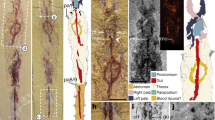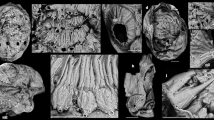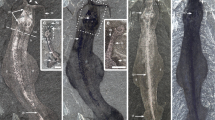Abstract
THERE is much interest in the early evolution of metazoans with the restudy of the Middle Cambrian 'soft-bodied' fauna of the Burgess Shale1. Several other, newly discovered Cambrian 'soft-bodied' faunas2 provide a wealth of new data. One of the oldest and best-preserved faunas was discovered in 1984 in Chengjiang in southern China3. This fauna is of early Cambrian age, about late Atdabanian4 (∼520–530 Myr BP)2. We now describe a new 'armoured lobopod' from the Chengjiang fauna. This animal shows close affinity with the enigmatic Microdictyon5. The conundrum Halludgenia6 is reinterpreted as another 'armoured lobopod', as are Xenusion7 and Luolishania8. The large plates set in pairs along the trunk are a synapomorphy of this group, which flourished soon after the 'Cambrian explosion'. Soft-part anatomy suggests that the group has affinities with the Burgess Shale 'lobopod' Aysheaia9. All these marine, Cambrian forms are here grouped with the extant, terrestrial velvet worms in the phylum Onychophora.
This is a preview of subscription content, access via your institution
Access options
Subscribe to this journal
Receive 51 print issues and online access
$199.00 per year
only $3.90 per issue
Buy this article
- Purchase on Springer Link
- Instant access to full article PDF
Prices may be subject to local taxes which are calculated during checkout
Similar content being viewed by others
References
Whittington, H. B. The Burgess Shale, 1–151 (Yale University Press, New Haven, 1985).
Conway Morris, S. Trans. R. Soc. Edinb. 80, 271–283 (1989).
Zhang, Wentang & Hou, Xianguang Acta palaeont. sin. 24, 591–595 (1985).
Qian, Yi & Bengtson, S. Fossils Strata 24, 1–156 (1989).
Chen, Junyuan, Hou, Xianguang & Lu, Haozhi Acta palaeont sin. 28, 1–16 (1989).
Conway Morris, S. Palaeontology 20, 623–640 (1977).
Dzik, J. & Krumbiegel, G. Lethaia 22, 169–181 (1989).
Hou, Xianguang & Chen, Junyuan Acta palaeont. sin. 28, 208–213 (1989).
Whittington, H. B. Phil. Trans. R. Soc. B 284, 165–197 (1978).
Hou, Xianguang & Sun, Weiguo Acta palaeont. sin. 27, 1–12 (1988).
Chen, Junyuan, Hou, Xianguang & Erdtmann, B. D. in Developments in Geoscience, Contribution to 28th International Geological Congress, 1989, Washington DC USA (ed. Chinese Academy of Sciences) 265–277 (Science Press, Beijing, 1989).
Conway Morris, S. A. Rev. Earth planet. Sci. 18, 101–122 (1990).
Conway Morris, S. in Palaeobiology, A Synthesis (eds Briggs, D. E. G. & Crowther, P. R.) 30–36 (Blackwell, Oxford, 1990).
Bengtson, S., Matthews, S. C. & Missarzhevsky, V. V. in Problematic Fossil Taxa (eds Hoffman, A. & Nitecki, M. H.) 97–115 (Oxford University Press, New York, 1986).
Gould, S. J. Nat. Hist., 6–16 (October, 1990).
Conway Morris, S. Science 246, 339–346 (1989).
Bengtson, S. Nature 345, 765–766 (1990).
Bengtson, S., Conway Morris, S., Cooper, B. J., Jell, P. A. & Runnegar, B. R. Mem. Ass. Australas. Palaeontols 9, 1–364 (1990).
Bengtson, S. in The Proterozoic Biosphere: A Multidisciplinary Study (eds Schopf, W. J, & Klein, C.) (Cambridge University Press, in the press).
Missarzhevsky, V. V. in Paleozoic Invertebrates of Mongolia (eds Tatarinov, L. P. et al.) 10–19 (Nauka, Moscow, 1977).
Briggs, D. E. G. & Conway Morris, S. in Problematic Fossil Taxa (eds Hoffman, A. & Nitecki, M. H.) 167–183 (Oxford University Press, New York, 1986).
Jaeger, H. & Martinsson, A. Geol. För. Stockh. Förh. 88, 435–452 (1967).
Thompson, I. & Jones, D. S. J. Paleont. 54, 588–596 (1980).
Ruhberg, H. Zoologica 137, 1–183 (1985).
Robison, R. A. J. Paleont 59, 226–235 (1985).
Dzik, J. in Problematic Fossil Taxa (eds Hoffman, A. & Nitecki, M. H.) 117–134 (Oxford University Press, New York, 1986).
Walcott, C. D. Smithson. misc. Collns. 57, 109–144 (1911).
Gould, S. J. Wonderful Life, 1–347 (Norton, New York, 1989).
Briggs, D. E. G. in Arthropod palaeobiology (Short courses in Palaeontology Vol. 3, GSA Dallas) 24–43 (Paleontological Society, 1990).
Briggs, D. E. G. & Fortey, R. A. Science 246, 241–243 (1989).
Butterfield, N. J. Paleobiology 16, 272–286 (1990).
Butterfield, N. J. Paleobiology 16, 287–303 (1990).
Author information
Authors and Affiliations
Rights and permissions
About this article
Cite this article
Ramsköld, L., Xianguang, H. New early Cambrian animal and onychophoran affinities of enigmatic metazoans. Nature 351, 225–228 (1991). https://doi.org/10.1038/351225a0
Received:
Accepted:
Issue Date:
DOI: https://doi.org/10.1038/351225a0
This article is cited by
-
A Cambrian unarmoured lobopodian, †Lenisambulatrix humboldti gen. et sp. nov., compared with new material of †Diania cactiformis
Scientific Reports (2018)
-
Hallucigenia’s head and the pharyngeal armature of early ecdysozoans
Nature (2015)
-
Hallucigenia's head
Nature (2015)
-
Decay of velvet worms (Onychophora), and bias in the fossil record of lobopodians
BMC Evolutionary Biology (2014)
-
Cambrian lobopodians and extant onychophorans provide new insights into early cephalization in Panarthropoda
Nature Communications (2012)
Comments
By submitting a comment you agree to abide by our Terms and Community Guidelines. If you find something abusive or that does not comply with our terms or guidelines please flag it as inappropriate.



